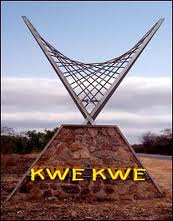This article does not cite any sources .(May 2019) (Learn how and when to remove this template message) |
Lalapanzi is a village in Midlands province in Zimbabwe. It straddles the Great Dyke, a mineral-rich geological formation that runs north-south down the center of the country. The name is also applied to the areas surrounding the town.

Zimbabwe, officially the Republic of Zimbabwe, is a landlocked country located in southern Africa, between the Zambezi and Limpopo Rivers, bordered by South Africa, Botswana, Zambia and Mozambique. The capital and largest city is Harare and the second largest being Bulawayo. A country of roughly 16 million people, Zimbabwe has 16 official languages, with English, Shona, and Ndebele the most commonly used.

The Great Dyke is a linear geological feature that trends nearly north-south through the centre of Zimbabwe passing just to the west of the capital, Harare. It consists of a band of short, narrow ridges and hills spanning for approximately 550 kilometres (340 mi). The hills become taller as the range goes north, and reach up to 460 metres (1,510 ft) above the Mvurwi Range. The range is host to vast ore deposits, including gold, silver, chromium, platinum, nickel and asbestos.
Built around the chromium mining business, with two of the largest mines operated by Lonrho (London Rhodesia Company), which has since given up its stake, and Zimasco (Zimbabwe Alloy and Steel Company). More recently, (starting in the 1990s) smaller, independent miners have accounted for larger volumes of the ore to leave the area. This has led to environmental problems as they are largely unregulated. Also has one post office, one very large police station, three clinics (two private, one state-run), one railway station, two primary and one secondary school.

Chromium is a chemical element with the symbol Cr and atomic number 24. It is the first element in group 6. It is a steely-grey, lustrous, hard and brittle transition metal. Chromium is the main additive in stainless steel, to which it adds anti-corrosive properties. Chromium is also highly valued as a metal that is able to be highly polished while resisting tarnishing. Polished chromium reflects almost 70% of the visible spectrum, with almost 90% of infrared light being reflected. The name of the element is derived from the Greek word χρῶμα, chrōma, meaning color, because many chromium compounds are intensely colored.
It has also been used as a dormitory town for the Sino-Zimbabwe cement company about 20 km west. However, since the commodity price collapse of the 1990s it has largely become a ghost town.

A ghost town or alternatively deserted city or abandoned city is an abandoned village, town, or city, usually one that contains substantial visible remaining buildings and infrastructure such as roads. A town often becomes a ghost town because the economic activity that supported it has failed, or due to natural or human-caused disasters such as floods, prolonged droughts, government actions, uncontrolled lawlessness, war, pollution, or nuclear disasters. The term can sometimes refer to cities, towns, and neighborhoods that are still populated, but significantly less so than in past years; for example, those affected by high levels of unemployment and dereliction.
















